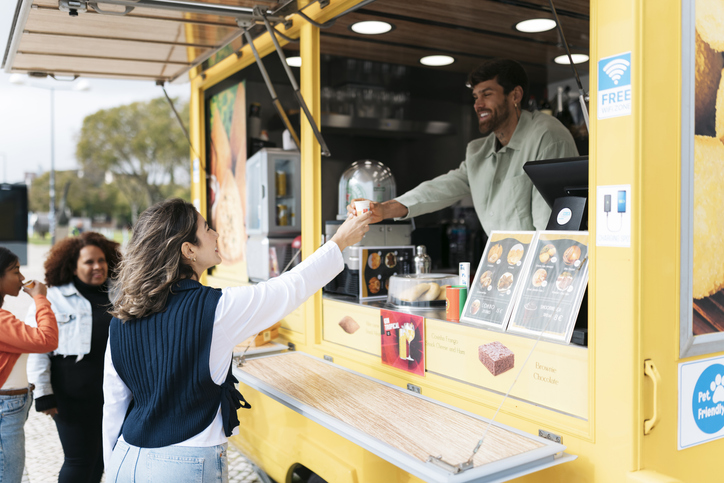Food trucks have transformed from simple lunch carts into thriving businesses that generate billions in revenue annually. This mobile food revolution offers entrepreneurs an accessible entry point into the restaurant industry without the hefty overhead costs of traditional brick-and-mortar establishments.
Starting a food truck business requires significant upfront investment. From purchasing the vehicle to outfitting it with commercial-grade equipment, securing permits, and stocking inventory, costs can quickly escalate. Fortunately, various financing options can help turn your culinary dreams into reality without draining your savings account.
This comprehensive guide explores the benefits of financing your food truck venture and walks you through proven strategies to secure the funding you need to launch successfully.
Why Finance Your Food Truck Instead of Paying Cash
Lower Upfront Costs
Financing allows you to spread the cost of purchasing your truck and equipment over time. Instead of depleting your savings with a large initial cash outlay, you can preserve working capital for other essential business needs. This approach reduces financial strain and helps you maintain a safety net for unexpected expenses.
Improved Cash Flow Management
By financing your food truck, you can allocate available cash toward operational needs like inventory, marketing campaigns, and employee wages. This strategic cash distribution helps maintain steady operations during your business’s critical early months when establishing a customer base and building revenue streams.
Building Business Credit
Consistently making loan payments demonstrates financial responsibility and helps establish your business credit profile. A strong credit history becomes invaluable when seeking additional financing for expansion, equipment upgrades, or seasonal inventory increases. This creditworthiness opens doors to better terms on future loans.
Tax Benefits
The interest paid on food truck loans often qualifies as a tax-deductible business expense. This deduction can lower your overall tax burden and increase your business’s profitability. Consult with a tax professional to maximize these benefits and ensure compliance with current regulations.
Access to Better Equipment
Financing enables you to invest in high-quality, commercial-grade equipment that might otherwise be financially out of reach. Superior equipment typically offers better performance, durability, and energy efficiency, ultimately contributing to your business’s long-term success and profitability.
Food Truck Financing Options
SBA Loans
Small Business Administration loans offer some of the most favorable terms for food truck financing. These government-backed loans reduce lender risk, often resulting in lower interest rates and extended repayment periods compared to conventional business loans.
Advantages:
- Lower interest rates than traditional loans
- Longer repayment terms (up to 25 years)
- Ability to borrow larger amounts
- Government backing reduces lender risk
Disadvantages:
- Complex application process
- Strict eligibility requirements
- Collateral may be required
- Slower approval times
Microloans
Microloans provide smaller amounts of capital, typically ranging from $500 to $50,000. These loans are ideal for entrepreneurs who need limited capital for equipment, inventory, or initial setup costs. Many nonprofit organizations and community development financial institutions offer microloans specifically for small businesses.
Advantages:
- Easier qualification requirements
- Faster approval process
- Flexible credit requirements
- Support from community organizations
Disadvantages:
- Higher interest rates
- Shorter repayment terms
- Limited loan amounts
Business Term Loans
Alternative lenders offer business term loans that provide lump sum financing for larger purchases like your food truck vehicle or major equipment. These loans typically have more flexible qualification requirements than traditional bank loans while offering competitive terms.
Advantages:
- Faster approval times
- Less stringent credit requirements
- Flexible terms compared to traditional banks
- Predictable monthly payments
Disadvantages:
- Higher interest rates than SBA loans
- Shorter loan terms
- May require personal guarantees
Equipment Financing
Equipment loans allow food truck owners to purchase specific equipment or vehicles by borrowing the necessary funds. The equipment itself serves as collateral, which often results in more favorable terms. Once you complete loan payments, you own the equipment outright.
Advantages:
- Equipment serves as collateral
- Lower interest rates than unsecured loans
- Build equity from the start
- Full ownership after repayment
Disadvantages:
- Down payment usually required
- Risk of equipment repossession if you default
- Equipment depreciation affects collateral value
Step-by-Step Guide to Securing Food Truck Financing
1. Research Market Costs
Begin by thoroughly researching food truck costs in your target market. Food truck prices vary significantly based on size, customization level, and geographic location. Factor in permits, licenses, health department approvals, and ongoing expenses like inventory and maintenance.
Create a comprehensive cost analysis that includes:
- Vehicle purchase or lease costs
- Kitchen equipment and appliances
- Permits and licensing fees
- Insurance premiums
- Initial inventory investment
- Marketing and branding expenses
2. Calculate Total Food Truck Investment
Develop a detailed budget that outlines both initial and ongoing expenses. Use spreadsheets to track costs and ensure accuracy. Include a contingency fund of 10-20% of your total budget for unexpected expenses.
Key budget categories include:
- Initial costs: Truck, equipment, permits, licenses
- Ongoing expenses: Food inventory, maintenance, insurance, fuel
- Working capital: Cash reserves for operations
- Emergency fund: Buffer for unexpected costs
3. Develop a Comprehensive Business Plan
Create a detailed business plan that demonstrates your venture’s viability to potential lenders. Your plan should include:
- Executive summary: Overview of your food truck concept
- Market analysis: Target demographic and competitive landscape
- Menu and pricing strategy: Detailed food offerings and pricing structure
- Marketing plan: Customer acquisition and retention strategies
- Financial projections: Revenue forecasts, expense estimates, and profitability timelines
- Management team: Your experience and qualifications
4. Assess Your Credit Worthiness
Check both personal and business credit scores to understand your financing options. Credit scores significantly impact loan approval odds and interest rates. Stronger credit scores unlock better terms and lower rates, while weaker scores limit options and increase borrowing costs.
Steps to improve creditworthiness:
- Pay down existing debt
- Ensure timely payments on all accounts
- Correct any errors on credit reports
- Avoid opening new credit accounts before applying
5. Compare Financing Options
Research various lenders including traditional banks, alternative lenders, government programs, and online platforms. Compare terms, interest rates, fees, and repayment schedules to identify the most cost-effective solution.
Evaluation criteria:
- Interest rates and annual percentage rates (APR)
- Loan terms and repayment schedules
- Fees and closing costs
- Lender reputation and customer reviews
- Flexibility for payment adjustments
6. Understand Qualification Requirements
Familiarize yourself with common lending criteria to avoid surprises during the application process. Lenders typically evaluate:
- Credit score (generally 650 or higher preferred)
- Annual revenue or projected income
- Business operating history
- Debt-to-income ratio
- Collateral availability
- Business plan quality
7. Gather Required Documentation
Prepare essential documents that lenders need to evaluate your application. Having these materials ready accelerates the approval process and demonstrates professionalism.
Required documents typically include:
- Personal and business tax returns (2-3 years)
- Bank statements (3-6 months)
- Financial statements and projections
- Business plan and supporting documents
- Legal documents (licenses, permits, contracts)
- Personal financial statements
8. Submit Your Application
Review all loan terms carefully before signing any agreements. Pay special attention to interest rates, repayment schedules, fees, and any prepayment penalties. Consider consulting with a financial advisor or attorney to ensure you fully understand the terms.
Key terms to review:
- Interest rate type (fixed or variable)
- Repayment schedule and monthly payment amounts
- Loan fees and closing costs
- Prepayment penalties
- Default consequences
- Collateral requirements
Frequently Asked Questions
What Can Food Truck Financing Cover?
Food truck financing can cover various business expenses including vehicle purchase, kitchen equipment, inventory, permits, licenses, insurance, marketing costs, and repairs. Some lenders offer comprehensive packages that cover multiple expense categories.
How Much Investment Does a Food Truck Business Require?
Initial investment varies based on location, vehicle type, equipment needs, and business concept. Costs typically range from $40,000 to $200,000 or more. Research your local market and create a detailed budget to determine your specific investment requirements.
What Credit Score Do You Need for Food Truck Financing?
Credit score requirements vary by lender and loan type. Generally, a credit score of 650 or higher improves approval chances and secures favorable terms. However, some lenders work with borrowers who have lower credit scores, though terms may be less favorable.
Can Personal Assets Secure Food Truck Financing?
Yes, personal assets can often serve as collateral for food truck financing. Lenders may accept vehicles, real estate, or other valuable assets as security. This collateral reduces lender risk and may result in better loan terms.
How Can You Get Financing with Poor Credit?
Options for poor credit include presenting a strong business plan, finding a creditworthy cosigner, starting with smaller loans to build credibility, and working with lenders who specialize in bad credit financing. Alternative lenders often have more flexible requirements than traditional banks.
Launch Your Food Truck Dream with Smart Financing
Securing appropriate financing is crucial for launching a successful food truck business. The right funding strategy reduces upfront costs, improves cash flow, and provides access to quality equipment while building your business credit profile.
Take time to research your options, prepare thorough documentation, and compare terms from multiple lenders. With careful planning and the right financing partner, your food truck venture can become a profitable reality that serves your community while achieving your entrepreneurial goals.
Start by calculating your total investment needs, then explore the financing options that best match your business requirements and financial situation. Your mobile culinary adventure awaits the right funding to get rolling.






